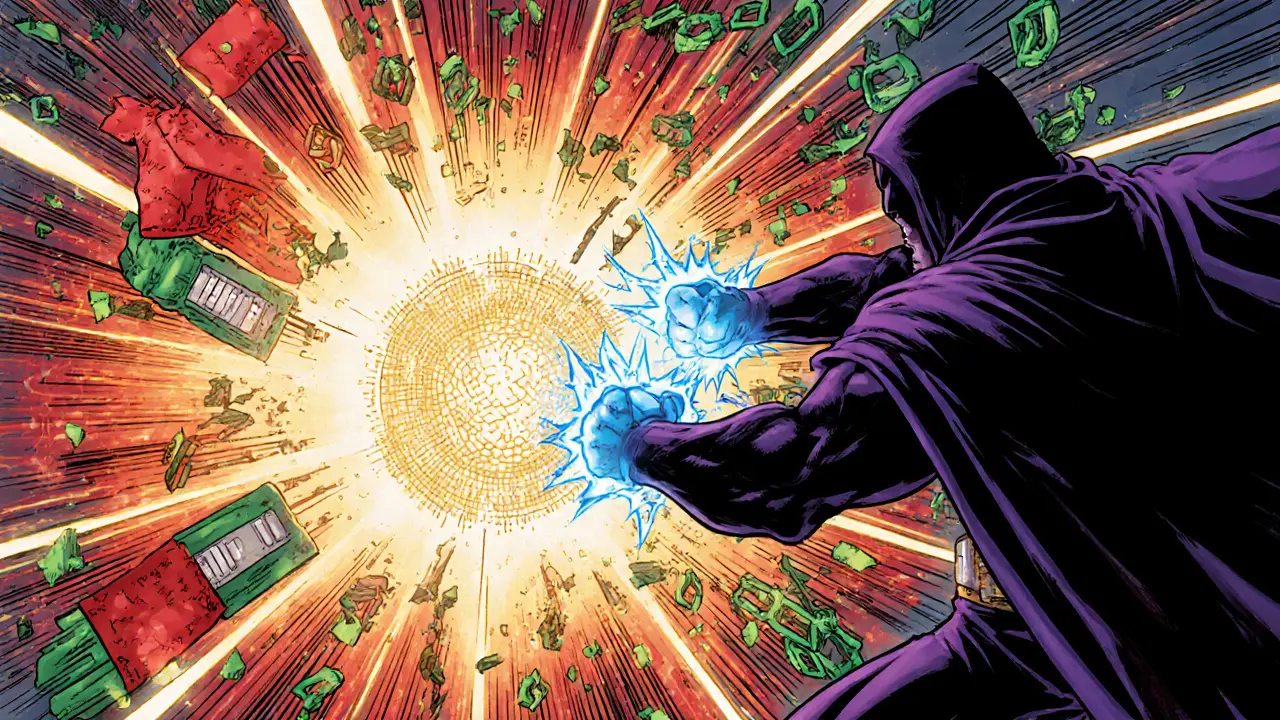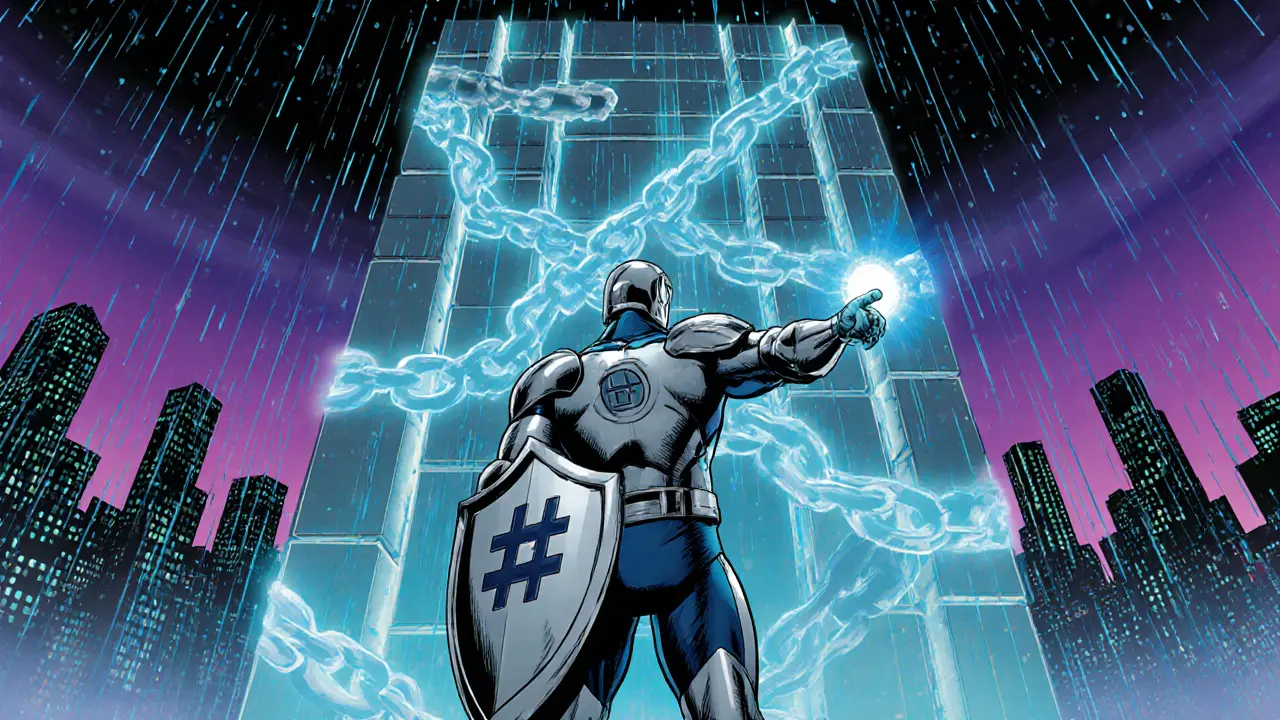Hash Collision Security Checker
Select a hash function below to check its collision resistance and security status:
| Algorithm | Output Size | Collision Resistance (bits) | Status |
|---|---|---|---|
| MD5 | 128 bits | ~48 (practical attacks) | Broken |
| SHA-1 | 160 bits | ~63 (SHAttered) | Deprecated |
| SHA-256 | 256 bits | ~128 (theoretical) | Secure (current) |
| SHA-3 (Keccak) | 256 bits (common variant) | ~128 (theoretical) | Secure (emerging) |
Imagine a world where you could change a past transaction on a blockchain without anyone noticing. That nightmare hinges on a single weakness: a hash collision. When two different inputs produce the exact same hash output, the cryptographic shield that keeps blockchains immutable cracks open. This article breaks down what a hash collision is, why it matters for blockchain security, and what developers and networks can do to stay safe.
Key Takeaways
- A hash collision occurs when distinct data map to the same hash value, breaking the core assumption of collision resistance.
- Blockchains rely on hash linking; a successful collision could let attackers rewrite history without detection.
- Modern chains use SHA-256 or SHA-3, which are orders of magnitude harder to collide than legacy algorithms like MD5 or SHA-1.
- Real‑world attacks (e.g., Google’s SHAttered SHA‑1 collision) show that even “old” hashes can become practical threats.
- Future defenses focus on quantum‑resistant hash designs and agile upgrade mechanisms.
What Is a Hash Collision?
A hash collision is a situation where two different inputs generate the identical output from a cryptographic hash function. Hash functions take any length of data and compress it into a fixed‑size string-commonly 128, 160, 256, or 512 bits. The design goal is that finding two inputs with the same output (a collision) should be computationally infeasible.
The inevitability of collisions is rooted in the Pigeonhole Principle: mapping an infinite set of possible inputs into a finite set of hash values guarantees overlaps. However, a well‑designed hash algorithm makes the search space so huge that an attacker would need astronomical time-think 2128 operations for SHA‑256-to succeed.
Why Collisions Threaten Blockchain Integrity
Every block in a blockchain stores the cryptographic hash of its predecessor. This creates an unbreakable chain: change any transaction, and the block’s hash changes, breaking the link with the next block. If an attacker could produce a different set of transactions that hash to the same value, they could replace the old block with a malicious one while preserving the chain’s continuity. The network would see a perfectly valid hash and accept the tampered history.
Such a breach would enable double‑spending, stealthy fund theft, and erosion of trust in the entire ecosystem. Because the hash link is the primary defense against retroactive tampering, collision resistance is the single most critical security property for blockchains.

Common Hash Functions in Blockchain and Their Resistance
Blockchains choose hash algorithms based on three cryptographic properties: one‑wayness, large output space, and non‑locality (small input changes cause large output changes). Below are the most prevalent functions and their security status.
MD5 an early 128‑bit hash function, broken in the mid‑2000s with practical collision generators available to anyone.
SHA-1 a 160‑bit algorithm deprecated after Google’s 2017 SHAttered collision demonstration, now considered insecure for new systems.
SHA-256 the 256‑bit workhorse of Bitcoin and many other chains, offering roughly 2128 operations to find a collision.
SHA-3 the latest NIST standard, designed with a sponge construction to improve resistance against both classical and quantum attacks.
Keccak256 Ethereum’s variant of SHA‑3, used in smart contract hashing functions like keccak256().
| Algorithm | Output Size | Collision Resistance (bits) | Status |
|---|---|---|---|
| MD5 | 128bits | ~48 (practical attacks) | Broken |
| SHA‑1 | 160bits | ~63 (SHAttered) | Deprecated |
| SHA‑256 | 256bits | ~128 (theoretical) | Secure (current) |
| SHA‑3 (Keccak) | 256bits (common variant) | ~128 (theoretical) | Secure (emerging) |
Real‑World Collision Demonstrations and Lessons
In 2017, Google’s research team announced a successful SHA‑1 collision dubbed “SHAttered”. The attack required roughly 263 hash operations-well within the reach of modern cloud farms. By crafting two PDF files that shared the same SHA‑1 hash, the team proved that even a widely adopted algorithm could be subverted, forcing the industry to accelerate its migration away from SHA‑1.
Other notable incidents include the creation of colliding MD5 certificates, which allowed attackers to forge SSL/TLS credentials. While these attacks targeted non‑blockchain systems, they illuminate a key truth: once a hash function is broken, any system that depends on its collision resistance-including blockchains-faces existential risk.
Mitigation Strategies for Developers and Networks
Preventing collision‑related failures involves both algorithm choice and implementation hygiene.
- Choose proven, high‑entropy hashes. Bitcoin continues to use SHA‑256; new projects should consider SHA‑3 or post‑quantum candidates vetted by NIST.
- Avoid unsafe encoding. In Solidity, the abi.encodePacked concatenates arguments without separators, leading to potential collisions if dynamic types are involved. Always add explicit delimiters or switch to
abi.encode. - Implement hash agility. Design protocols allowing a smooth transition to a new hash function via on‑chain governance or soft forks.
- Monitor cryptographic research. Stay informed about breakthroughs in collision attacks, especially those leveraging machine learning or quantum algorithms.
- Audit smart contracts. Include collision checks in security reviews; tools like Slither and MythX flag unsafe hashing patterns.
Network‑level defenses also matter. Ethereum’s roadmap includes a “hash upgrade” mechanism that can trigger a chain‑wide switch if a vulnerability is discovered. Bitcoin Core, on the other hand, prefers stability and only adopts new hashes after extensive peer review.
Future Outlook: Quantum Threats and Post‑Quantum Hashes
Quantum computers threaten traditional hash functions by offering quadratic speedups via Grover’s algorithm. In practice, a quantum adversary could halve the effective security bits-turning SHA‑256’s 128‑bit collision resistance into roughly 64 bits, which is within reach of projected large‑scale quantum machines.
To counter this, the cryptographic community is standardizing quantum‑resistant hash constructions. NIST’s post‑quantum project evaluates candidates like SPHINCS+ (a hash‑based signature scheme) and new sponge‑based functions designed to retain collision resistance even against quantum queries.
Blockchains can future‑proof by adopting hash‑agility frameworks that allow a rapid switch to these post‑quantum hashes without a hard fork. Projects experimenting with multi‑hash approaches-requiring simultaneous collisions across two independent algorithms-add another layer of defense, making an attack exponentially harder.

Frequently Asked Questions
What exactly is a hash collision?
A hash collision occurs when two different inputs produce the same fixed‑length hash output. This breaks the assumption that each unique input maps to a unique hash, which is essential for data integrity and security.
Can a hash collision let someone alter blockchain history?
Yes. If an attacker finds a collision for the hash linking two blocks, they could replace the original block with a malicious one that hashes to the same value, keeping the chain technically valid while changing the transaction data.
Why are SHA‑256 and SHA‑3 considered safe today?
Both produce 256‑bit outputs, giving a theoretical collision resistance of 2128 operations. No practical collision attacks have been demonstrated against them, and the computational effort required exceeds current and near‑future hardware capabilities.
How does Solidity’s abi.encodePacked create collision risks?
When multiple dynamic types are concatenated without a separator, different input combinations can produce the same byte string. An attacker can craft alternative inputs that hash to the same value, compromising functions that rely on the hash for uniqueness.
What steps should a blockchain project take to prepare for quantum attacks?
Adopt hash‑agility in the protocol, monitor NIST post‑quantum standards, and consider hybrid schemes that combine classical and quantum‑resistant hashes. Regular audits and community voting mechanisms help roll out upgrades without disrupting the network.


Millsaps Delaine
January 6, 2025 AT 03:00When we explore the esoteric underpinnings of blockchain cryptography, we must first acknowledge the lofty ambition that the original architects held: to forge an immutable ledger immune to the most nefarious of attacks. Yet, the notion of a hash collision, that seemingly innocuous mathematical coincidence, shatters this ideal with a brilliance that borders on the theatrical. A collision permits the substitution of an entire block’s transaction set without altering the cryptographic fingerprint that links it forward, thereby opening a clandestine corridor through which history can be rewritten in the shadows. The gravity of such a breach is not merely academic; it threatens the very economic foundations upon which decentralized finance is built, eroding trust in a system predicated on transparency. Moreover, the computational effort required to engineer a collision against SHA‑256, while astronomically large, is not an immutable barrier in the face of relentless advances in parallel processing and quantum algorithms. One must also consider the cascading effect on sidechains and layer‑2 solutions that inherit the same hash assumptions, creating a systemic risk that propagates like a contagion. It is incumbent upon developers to integrate hash‑agility mechanisms, allowing for swift migration should a weakness be exposed, rather than clinging to an ossified standard. The community must also invest in post‑quantum hash constructions, for the specter of Grover’s algorithm looms on the horizon, halving effective security margins. In practice, a multi‑hash strategy-requiring simultaneous collisions across two independent functions-offers an exponential increase in attack complexity, rendering the prospect of a successful exploit virtually untenable. Finally, rigorous peer review, open‑source audits, and continuous monitoring of cryptographic research are non‑negotiable pillars of a resilient blockchain ecosystem. Only through such a comprehensive, forward‑thinking approach can we hope to preserve the sanctity of immutable ledgers against the inexorable tide of computational progress.
Jack Fans
January 11, 2025 AT 21:53Wow, what an insightful breakdown, and I must say, the points about hash‑agility are spot‑on, definatly especially for newer projects that want to stay ahead of the curve; however, let me add a practical note, when deploying smart contracts, always double‑check your abi.encodePacked usage, because accidental concatenation errors can introduce subtle collisions, which many developers overlook, and this is where a simple code audit can save you from future headaches. Also, consider layering SHA‑256 with a secondary hash like Blake2b for added safety, a technique that’s gaining traction in the community. Lastly, keep an eye on the NIST post‑quantum candidates-they’re not just theoretical; implementations are already emerging, and early adoption can future‑proof your chain. Cheers!
Adetoyese Oluyomi-Deji Olugunna
January 17, 2025 AT 16:46The ontological ramifications of a mere binary coincidence transcend mere engineering concerns, echoing the very dialectic of determinism versus chaos, albeit with a dash of computational inevitibilty-though perhaps the author has overstated the immediacy of such perils, given the current computational infeasibility of breaching SHA‑256's sanctified scaffolding.
Krithika Natarajan
January 23, 2025 AT 11:40I understand the concerns and appreciate the nuanced view.
Ayaz Mudarris
January 29, 2025 AT 06:33Esteemed colleagues, let us embrace the rigor of cryptographic best practices as a cornerstone of our collective endeavour; by selecting robust hash functions such as SHA‑256 or SHA‑3 and instituting transparent upgrade pathways, we not only safeguard the integrity of our ledgers but also foster confidence among participants, thereby catalyzing broader adoption and reinforcing the very ethos of decentralized trust that underpins our industry.
Irene Tien MD MSc
February 4, 2025 AT 01:26Ah, the grand tapestry of "blockchain security" woven by the ivory‑towered elites, who, with a flick of their artisanal beards, proclaim that SHA‑256 is the impregnable fortress of the digital age-how delightfully naïve! One can almost hear the hushed murmurs in dimly lit conference rooms as they extol the virtues of a hash function that, in reality, teeters on the precipice of quantum annihilation. Let us not forget the quaint anecdote of the SHAttered collision, a masterstroke that exposed the fragility of SHA‑1 and sent shockwaves through the cryptographic community, yet somehow the same hubris permeates discussions about SHA‑256, as if the mere increase in bit length transmutes it into a deity. Meanwhile, the clandestine cabal of quantum researchers churns away, promising to halve security margins with a wave of Grover's algorithm, a reality that the "security‑by‑obscurity" crowd prefers to ignore. The proliferation of multi‑hash schemes, the insistence on hash‑agility, and the relentless push for post‑quantum standards are not mere buzzwords; they are the lifelines that prevent us from sailing straight into a cryptographic abyss. So, dear architects of immutable ledgers, perhaps it is time to shed the rose‑tinted lenses and confront the harsh truth: without proactive adaptation, our beloved blockchains may become as obsolete as floppy disks in a cloud‑centric world. The colorfully vivid future we envision-one where decentralized finance reigns supreme-depends on our willingness to confront these uncomfortable realities with both humility and resolve.
kishan kumar
February 9, 2025 AT 20:20In contemplating the metaphysical substrate of cryptographic primitives, one discerns a subtle interplay between entropy and determinism, wherein the hash function emerges as a epistemic bridge, translating the chaotic influx of data into a deterministic fingerprint, thereby endowing the blockchain with an aura of immutable truth. 😊
Anthony R
February 15, 2025 AT 15:13Indeed, the articulation presented above captures the essence of the philosophical discourse, however, it is imperative to underscore the pragmatic implications: developers must enforce strict input validation, incorporate versioned hashing schemas, and maintain comprehensive audit trails, lest the theoretical elegance be rendered moot by operational oversights. Additionally, comprehensive documentation, regular code reviews, and community‑driven standards are vital components of a resilient security posture.
Vaishnavi Singh
February 21, 2025 AT 10:06The delicate equilibrium between computational feasibility and security assurance invites a contemplative pause, reminding us that the pursuit of absolute certainty may be as illusory as the notion of a perfectly immutable ledger in an ever‑evolving technological landscape.
Linda Welch
February 27, 2025 AT 05:00The American blockchain pioneers tout their superiority with blustering bravado yet ignore the stark reality that reliance on legacy hash functions is a strategic vulnerability, one that foreign adversaries are poised to exploit with sophisticated quantum resources; this hubris undermines national security and betrays the very principles of technological independence; while domestic developers cheer for decentralized autonomy, they paradoxically depend on cryptographic standards crafted in foreign labs, a contradiction that cannot be sustained; the path forward demands an unapologetic commitment to indigenous research, rapid adoption of post‑quantum hash schemes, and a rigorous overhaul of legacy protocols, lest the United States cede its digital sovereignty to unseen adversaries; only then can we truly claim leadership in the blockchain arena
Kevin Fellows
March 4, 2025 AT 23:53Great points everyone, let’s keep pushing forward and stay secure!
meredith farmer
March 10, 2025 AT 18:46Oh, the drama! While we cheerfully march ahead, hidden forces conspire to twist every hash into a weapon of chaos, and I can’t help but feel the walls closing in as unseen eyes watch our every block, waiting for a slip‑up to unleash mayhem-truly, the tension is palpable.
Peter Johansson
March 16, 2025 AT 13:40Team, remember that continuous learning and peer‑review are your strongest allies; by sharing insights, mentoring newcomers, and celebrating incremental security wins, we build a resilient community that can weather any cryptographic storm 😊.
Cindy Hernandez
March 22, 2025 AT 08:33Your encouragement resonates well, and it’s essential we pair optimism with concrete action plans, such as scheduled security audits and incremental adoption of emerging hash standards, to ensure our collective progress remains both hopeful and grounded.